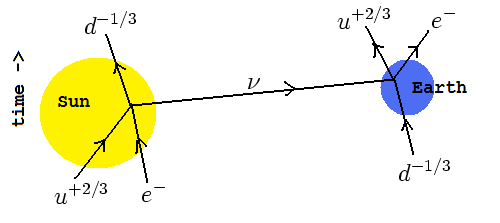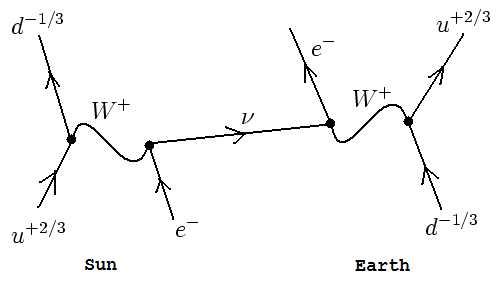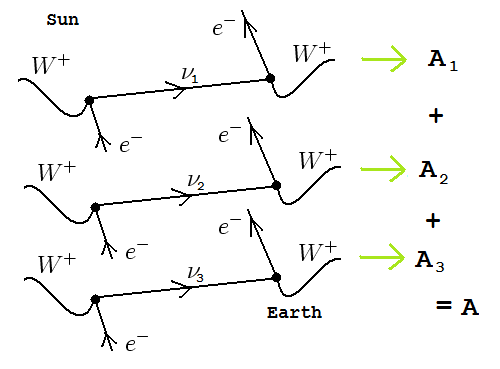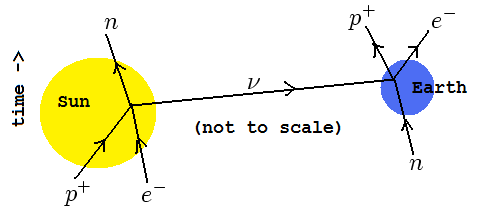Neutrinos are constantly being emitted by the sun in prodigious numbers. About 10^14 go through your body each second (maybe more if you supersize yourself like my old buddy Mario did). More technically, anti-neutrinos are created when neutrons decay into a proton + electron + anti-neutrino, and neutrinos are created when protons absorb electrons in the reverse process: proton+electron -> neutron + neutrino. These sorts of things happen to various atoms of the sun, depending on what sort of decay they are subject to, (beta decay or reverse beta decay, respectively), as well as proton-proton collisions that produce a positron a deuteron (PN), and a neutrino. However, not enough neutrinos seem to arrive on earth. This was known quite some time ago, see The Solar Neutrino Problem for the technical details as of 1998.
The explanation for the deficit in neutrinos is now called “neutrino oscillation.” In the theory of neutrino oscillation, these solar neutrinos are “electron neutrinos”, and in their passage to the earth, they change form and become “muon neutrinos” or “tau neutrinos.” For those students who take their physics on faith, this is not a problem. But every now and then someone learns their theory just a little too well and begins to have doubts about how it can be that a particle can transform itself into another particle in vacuum. Yes, neutrino oscillation is a little strange, but it can be explained much more clearly, and kept in context with the rest of particle physics, by analyzing the problem as neutrino interference. This way neutrino oscillation can be described in a way that doesn’t confuse students. And such is the topic of this post.
First, let’s write down the interaction that is at the heart of the detection of solar neutrinos. The solar neutrino deficit was first discovered by the chlorine detector at the Homestake gold mine. This detector consisted of as much chlorine as one could reasonably pack into a small volume, and placed as deep underground (and protected from cosmic rays and other radiation)as possible. The expectation was that a neutrino would arrive and convert a Cl-37 atom to a Ar-37 atom, plus an electron. That is, a neutron in the nucleus of the chlorine atom is converted into a proton, plus an electron. In short, this is the interaction . The atomic mass is unchanged. The neutrino was created in the sun by a reverse sort of interaction, an electron capture:
. There is other stuff going on, but this is enough to establish the problem and its solution.
So what happens is this: A proton and an electron in the sun are combined into a neutron. On the earth, a neutron is split into a proton and an electron. And a neutrino is exchanged. This is illustrated in the figure above. At a deeper level of detail, what is happening is that an up quark in the sun’s proton is being converted into a down quark, and on the earth, a down quark in the neutron is being converted into an up quark. This further complication doesn’t change the picture much, we now have:

And modern theory no longer treats the above interaction as two 4-body interactions; it will be better if we follow convention and split the neutrino emission and absorption up by putting a W boson between the quarks and leptons. And I’ll drop the cute earth and sun pictures:

Now the problem with all this was that the number of neutrinos being detected on the right did not seem to equal the number of neutrinos that were pretty much known to be emitted on the left. Something was happening to them.
The CKM Matrix
A clue was given by the up quark and down quark interactions on the far left and far right of the above drawing. On the left, an up quark turns into a W+ boson and a down quark. On the right, a down quark absorbs a W+ and turns into an up quark. It turns out that these interactions are not quite so simple. While there is only one W+ boson, the quarks come in three generations. The three generations have different masses but otherwise have the same quantum numbers (depending on what you call a quantum number).
So when an up quark emits a W+ boson it can turn into other quarks than just the down quark. Electric charge has to be conserved, so the other possible quarks, besides the down, with charge -1/3, are the strange and bottom. Now over the long term, since the strange and bottom quarks weigh more than the up quark, the interaction will end up with just the down quark (the strange and bottom quarks will convert to a down quark, or be reabsorbed, or do something cool).
But on a short enough time scale, any of the down quarks (d,s,b) can end up created along with that W+. Like anything in quantum mechanics, there are different probabilities of these things happening. And, like anything in quantum mechanics, there are different phases, which can cause interference. Our sum total knowledge of what happens in this interaction is held in the Cabibo-Kobayashi-Masakawa (or CKM) matrix. In order to provide phase information, the matrix entries are amplitudes. The entries of the matrix specify an up type quark (u,c,t) and a down type quark (d,s,b). It has 3×3 = 9 entries, running from “ud” to “tb”; each entry “xy” defines the amplitude that when a the W+ emitted by an “x” quark with charge +2/3, the resulting quark with charge -1/3 will be the “y” quark.
According to the latest Wikipedia data, the entry for the CKM matrix is 0.97383. It’s an amplitude, so to get a probability we have to square it; the resulting probability for the down quark is about 94.83%. So this isn’t much of a cause for a neutrino deficit; and as I mentioned above, this doesn’t matter anyway, a higher generation quark would just decay down to the d anyway.
So the CKM matrix can’t explain the loss of those neutrinos. You might say that the neutrinos were there but we weren’t detecting them, but the detection rates were found by comparing the number of detections of neutrinos from nearby nuclear reactors; physicists had a good idea how many should be detected.
The MNS Matrix
But there is a way to arrange for fewer than expected interactions, if the neutrinos have mass, and if they have a generation structure like the quarks (and the charged leptons, that is, the electron and its cohorts, the muon and tau). This is quite a stack of ifs, but making this assumption makes the neutrinos look more like the other leptons and quarks. We will call the three neutrinos as is done in the literature. At this time, it is not known which of these neutrinos is the lightest.
If there are three neutrinos, then there is a mixing matrix for how the W+ interacts with them. The matrix is called the Maki-Nakagawa-Sakata matrix or MNS matrix. (Why doesn’t the MNS matrix get its own wikipedia entry like the CKM matrix does? Non-neutrality?) Like the CKM matrix, there are 3×3 = 9 entries in the matrix. The first entry is and designates the charged lepton that absorbs the W+. The second entry, 1,2,3, designates the neutrino.
In quantum mechanics, one computes probabilities by taking the squared magnitudes of amplitudes. The amplitudes are obtained by adding up all the possible amplitudes that can contribute to the problem. Since we now have three neutrinos, there are now three amplitudes contributing the probability that we detect that “neutrino.” The total amplitude A is given by the sum of the amplitudes for the three neutrinos:

Now when we do these sorts of calculations, we have to assume an energy for the neutrino. If we’re not sure of the energy, then we do the calculation for each energy that is possible, and then compute an average. But for a given energy, in quantum mechanics the de Broglie frequency and wavelength of a particle depends on the mass. Thus the three neutrinos will pick up different relative phases, and the three amplitudes, will interfere with each other; that is, the sum will change in magnitude as the individual contributions go into and out of phase with each other.
Neutrino “Oscillation”
So when the neutrinos are first created a W+ and an electron, they are just perfect for converting back into an electron and a W+. As you get farther and farther away from the source, the three types of neutrinos begin interfering with each other more and more. Eventually their phases become random. The result is a decreased probability of detection. The solar neutrinos are there, but we don’t detect all of them because their relative phases are inconvenient for our detectors.
In the historical developement of particle physics, at first it was assumed that neutrinos could not interfere. So they called the neutrinos by names defined by what they did. In the literature still today it is common to call the three neutrinos . But these “flavor eigenstate” neutrinos require three regular Feynman diagrams to describe. They are not mass eigenstates and they are not solutions of a Dirac equation (which requires a mass like any other fermion).
Every now and then you will see people talking about the mass of the “electron neutrino”. In this case, they are talking about an average mass, after translating the electron neutrino into the true neutrinos, the . And this is another source of confusion for the student. It would be much easier if they used the same conventions with the neutrinos as are used for most other elementary particle and talked about the mass eigentates as the particles.
Conclusion
What amazes me about neutrino interference is how quantum mechanics works even though the intermediate (virtual) states travel the distance from the sun to the earth. The trip takes several minutes, and yet, the three neutrinos manage to interfere with each other when they arrive. I think that’s awesome. This universe is a very strange place.
So I’d like this to be a resource for students wishing to understand neutrino oscillation. If you have questions, add them to the end and I’ll try to answer them. And corrections, of course, I’ve typed this up in just two hours and it is undoubtedly filled with errors. And surely I’ve left something off here.
Research Going On Around Here
Of course I am responsible for extending Koide’s mass formula for the charged leptons to the neutrinos. The oldest paper is The Lepton Masses (2006). My formula for the neutrino masses was mentioned by Alexei Smirnov at a plenary lecture at the Neutrinos-2008 meeting as a non perturbative method of looking at the generation structure of the neutrinos. So if I’m off the deep end, at least I’m not completely alone in the water. Most of my efforts right now are on extending the Koide formulas to the quarks, which I’m writing up here. Kea is busily working on the mixing matrices. She’s starting with the MNS (lepton) matrix which is quite regular and fits in with stuff I’m doing. I’m hoping that she will tackle the CKM matrix and help explain the quarks.


Fantastic post! Oh dear, Carl, I have lots of ideas for those numbers in the CKM matrix but goodness knows how long it will take to get anywhere, especially after days like today – we had a full restaurant and 50 French guys gulping large quantities of Kiwi wine and creme brulee.
Fascinating discussion of neutrino oscillation.
If there is wave interference between neutrinos in transit from the Sun to the Earth, shouldn’t such wave interference also occur for other particles in transit (not necessarily from Sun to Earth)? And if so, where is that particle’s “oscillation”?
Re: “shouldn’t such wave interference also occur for other particles in transit (not necessarily from Sun to Earth)?”
Yes! A very good question, and one that has been asked many times before. Congratulations, you are paying attention!
Those other particles do interfere. For example, muons and electrons from the sun also interfere with each other, at least in theory. However, practically, we’re about 8 minutes from the sun and it would be a heck of a fast muon that could last that long. Their average lifetime is about 2.2 microseconds, so they would need a lot of speed to lengthen their life to 8 minutes.
In addition, for the interference to occur, you would have to have a process that can emit either an electron or a muon. And the muon / electron would have to get to the earth without a lot of interactions that would disturb the phases (such as interactions in the cosmic wind). The thing about neutrinos is that they don’t interact very much, that’s why it’s so easy to see the interference.
And finally, the distance over which the oscillation occurs is given by the difference in their frequencies of oscillation. And that depends on their difference in mass. (Actually the difference in the squares of their masses.) The various neutrinos have masses that are very close together, less than 0.05 eV, (depending on some assumptions we can ignore for now). The difference in mass between the electron and the muon is 105.2 MeV, that is, about 2 billion times larger than the difference in the neutrino masses! Squaring the masses makes it even bigger! So the effect occurs over a much much shorter distance.
And for those much shorter distances, yes, particle physicists have to take into account interference between electrons and muons. This is done by adding together all the amplitudes for the approrpriate Feynman diagrams, before computing the magnitude and squaring it. The process is just like the neutrino interference calculation I outlined here.
One minor typo where you write “The three generations have the same mass but otherwise have the same quantum numbers…”
David, without further explanation I’m going to leave it the way I’ve got it. There are two possible problems you’re alluding to, that I can think of.
(1) “Different generation particles are distinguished by quantum numbers like “strangeness”, etc.”
Some people like to think of these as quantum numbers, I do not, especially in the context of weak physics, as they are not preserved by the weak interaction.
(2) “Mass is not a quantum number.”
In bound states, the energy is a quantum number and since E=mc^2, mass is also such. Since energy is conserved, energy makes a good quantum number. The place you’re likely most familiar with energy as a quantum number is the “n” in the “nlm” quantum numbers for the bound states of hydrogen.
But in any case, this is just a matter of definitions, and physics should be a computational sport, not a dictionarial one.
Carl, the generations give different masses. It’s just a typo.
Yes, what Kea said. Sorry, if I thought the problem wasn’t obvious I’d have pointed it out more… pointedly.
Further down the page, the “stack of ifs” in “…if the neutrinos have mass, and if they have a generation structure like the quarks (…), and if the neutrinos have mass…” could be slimmed by removing the duplicate “if the neutrinos have mass” statement.
Whoa, no, that wasn’t a typo, that’s early onstage adult dementia! Yeah, and I also tend to get minus signs wrong. When I wrote that, I was feeling guilty, but for the wrong reasons. I’ll fix both things immediately.
Pingback: Neutrino Oscillation; the Calculation « Mass
It’s okay Carl. Feynman had trouble with minus signs too. Happens to people who concentrate on the big picture.
Kris, I’ve been running full throttle on this stuff for three years now and my brain is approaching the point of know return. All I want to do now is retire to some out of the way place (Kansas I suppose), make porcelain and glass, and maybe play a little chess, assemble a few jigsaw puzzles, and maybe fill the numbers in on a few easy sudokus. Oh, listen to some obsolete rock and roll and maybe garden.
I spent (I think) two weeks trying to understand the weird Koide formula for the b-bbar and c-cbar mesons. The posts on the neutrinos were to get my mind off the real problem. I can see a little light at the end of the tunnel cause I’ve got Kea working on the mixing matrices and she’s making amazing progress that seems to fit in nicely with the meson masses.
Carl, it’s great Kea is helping you! A team can’t be so easily neglected.
Could you work on little jigsaw puzzles in Kansas and leave behind the biggest one of all?
Kris, I’m not too worried about neglect. If this isn’t the right way, then by being neglected we’re not wasting people’s time. And if it is the right way, then we’re getting way ahead. But I won’t abandon it until I see people working on it harder than I am.
The cool thing about Kea is that we can feed each other ideas. I can’t believe how much she has brought me around on the very abstract way she looks at things.
Carl is right in principle about the neglect, but I do wish I didn’t have to worry about starving to death.
A nice new article on arXiv, 1001.4815 , compares QM and QFT calculations for neutrino oscillation. The QFT is the more correct method and requires mass eigenstates as is necessary for the neutrino interference calculations done here.
Hi,
thank you very much for this explanation of neutrino oscillations. If I understand you right ,you replace the usual explanation “In the W decay a neutrino flavour eigenstate is produced, which is a superposition of the different mass eigenstates” by the the explanation “In the W decay each mass eigenstate can be produced and we have to add the amplitudes of all these processes”. Is this right so far?
I’m now wondering, if it’s possible to explain meson oscillations (let’s say neutral Kaons) in an analog way. So could we replace the usual statement “In a proton antiproton collision a K⁰ is produced by strong interaction and this K0 is a superposition of K_L and K_S” by the statement “In a proton antiproton collision an K_L and a K_S can be produced and we have to add the amplitudes for both processes” ?
My first guess was: Of course, that is exactly the same as for the neutrinos. But now the next step would be to write down the feynman diagrams (at the quark level) for both of the processes we have to add, as you did for the neutrinos. And here I get stuck. It’s so easy to write feynman diagrams for the K0, you just have to draw a line for the d and the s^bar, and this is done many times. But what should represent a K_S or a K_L ? How does for example the feynman diagram look like, which describes the decay of a K_S into pions?
Than I looked into the pdg table (http://pdg.lbl.gov/2010/tables/rpp2010-tab-mesons-strange.pdf) and things became even more confusing. There they don’t only list K_S and K_L as particles, but also K0 and they even give a mass for the K0. This is confusing because in analogy to the neutrinos I would expect that the K0 is no mass eigenstate and therefore you could not give a mass for it. So now I would of course like to check if K_S and K_L are mass eigenstate and K^0 isn’t one, but I don’t know how to do that. For the neutrinos as elementary particles it’s quite easy: I basically have to look at the SM Langrangian, collect terms quadratic in nu and diagonalize to get the mass eigenstates. But how can I check if K0 or K_S,L is a mass eigenstate by starring at the SM Lagrangian?
Apart from the feynman diagram and the mass issue there is a third thing which is confusing me. In almost all descriptions of Kaon oscillations a box diagram like http://en.wikipedia.org/wiki/File:Kaon-box-diagram.svg is shown. This suggests that it is the occurrence of this process which leads to the observed oscillations. But in the above argumentation this process isn’t needed at all! Maybe the *existence* of such a diagram is needed, because such a diagram shows that K0 and K0bar can decay in the same final state. But first I think it would be more important to show that K_L and K_S can decay into the same final state (otherwise there wouldn’t be two amplitudes we have to add) and second, the process itself doesn’t contribute to the oscillation (only in higher corrections) in my opinion. Indeed, you could have drawn a similar diagram for the neutrinos, showing a nu_1 decaying into an e- and a W+, which than join to build an nu_2. But this process never happens in your argumentation. So why is such a process always shown for the K0 ? Is it because I’m on the wrong track and there is some fundamental difference in neutrino and kaon oscillations?
Best,
Ernie
Dear Ernie; I think you understand this article perfectly and that you’re on the right track with the kaon. It’s just a change of basis.
For the K_0, the two bases are “strong” and “weak”. They’re created in the strong basis but decay in the weak. So neither of these is (exactly) the mass basis I would surmise. But if you read the literature, you will find that it is possible to give masses to weak eigenstates even when they’re not also mass eigenstates. Basically you end up with a weighted (pun) average.
The K_L and K_S have a mass difference listed as 2.2 x 10 ^ -5 eV in wikipedia. Unlike the neutrinos, this is a tiny fraction of their total mass.
Pingback: Il neutrino supera la velocità della luce | BLOGSPOT TEMPLATES
Pingback: Il neutrino supera la velocità della luce « TuttiDentro
Pingback: Il neutrino supera la velocità della luce « GruppoLocale.it
Pingback: Il neutrino supera la velocità della luce | WORDPRESS PORTAL
if the neutrinos were different is it possible they divided into 4 quarks and you couldn’t see the other 50%?
that could be why 50% were seen on one side and 50% were not.
if it’s going up and down would the pull of gravity be stronger from the bottom of it (flying towards the ground) and the gravity not as strong (flying up in the air)
would that make a difference?
Carl
Thank you so much, I am writing an undergrad thesis dealing with the results from the Daya Bay Core Anti-Neutrino Experiment and I understood why neutrino oscillation is dependent on their mass in terms of the equations that represent neutrino oscillation but I did not really understand the true physical reasons those equations are valid until I read this. I truly appreciate your time and effort to help aspiring physicists like myself.